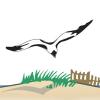We were elated and a bit awestruck as we recently witnessed the two newest additions to our neighborhood nesting.
As reported in the Cape Gazette in its May 3 edition, “Eagles making home in Fourth Street Preserve,” two of these majestic raptors, who mate for life, are making their home in one of the few areas in our community spared from the developer’s bulldozers. In the dim light of dusk, they could be seen gathering sticks and large twigs and flying them back to the nest, located in the crux of some branches atop a large preserved tree. Nests can weigh up to a ton, with the largest recorded in Florida at nearly two tons. The female places the sticks and builds the nest. Such important work, it seems, is not left to the male.
It appears they are already reaching the impressive wingspan of between 5.5 to 8 feet. The female is typically larger by 25%, weighing in at 10 to 15 pounds.
Perhaps the Gazette can run a naming campaign? George and Martha, to honor our status as Delaware’s first town and our rich colonial heritage? Or on a humorous note: George and Gracie? George Burns kinda looked like an eagle.
And perhaps DNREC’s Division of Fish and Wildlife could place a small, unobtrusive camera near the nest so we could all see in real time mom and dad preparing for the big day? Several wildlife centers do this, and it is a wonderful way of investing the community in the life of wildlife around us.
It is sad that already so much of our ecology and natural beauty is being lost to out-of-control development. We have a county council, elected in part from generous donations from developers, who plead that they are powerless to put the brakes on, victims of the county ordinances which were written to favor development even when it is against the interest of the larger community.
Here in Lewes, the planning commission, on which I serve, is taking steps to rewrite our ordinances on open space preservation and wetlands and coastal flood protection. We are presenting these to city council for active consideration. The county, which controls most of our land use, must follow suit. We need courageous commissioners who are willing to stand up to moneyed interests and put the future and well-being of our community first. Groups like the Sussex Preservation Coalition, the Sussex County Land Trust, the Center for the Inland Bays and the Greater Lewes Foundation are making significant strides in this direction.
Otherwise, no more eagles will be landing and nesting. We are choosing whether we share this arc with the diversity of wildlife, flora and fauna that make life possible.

















































